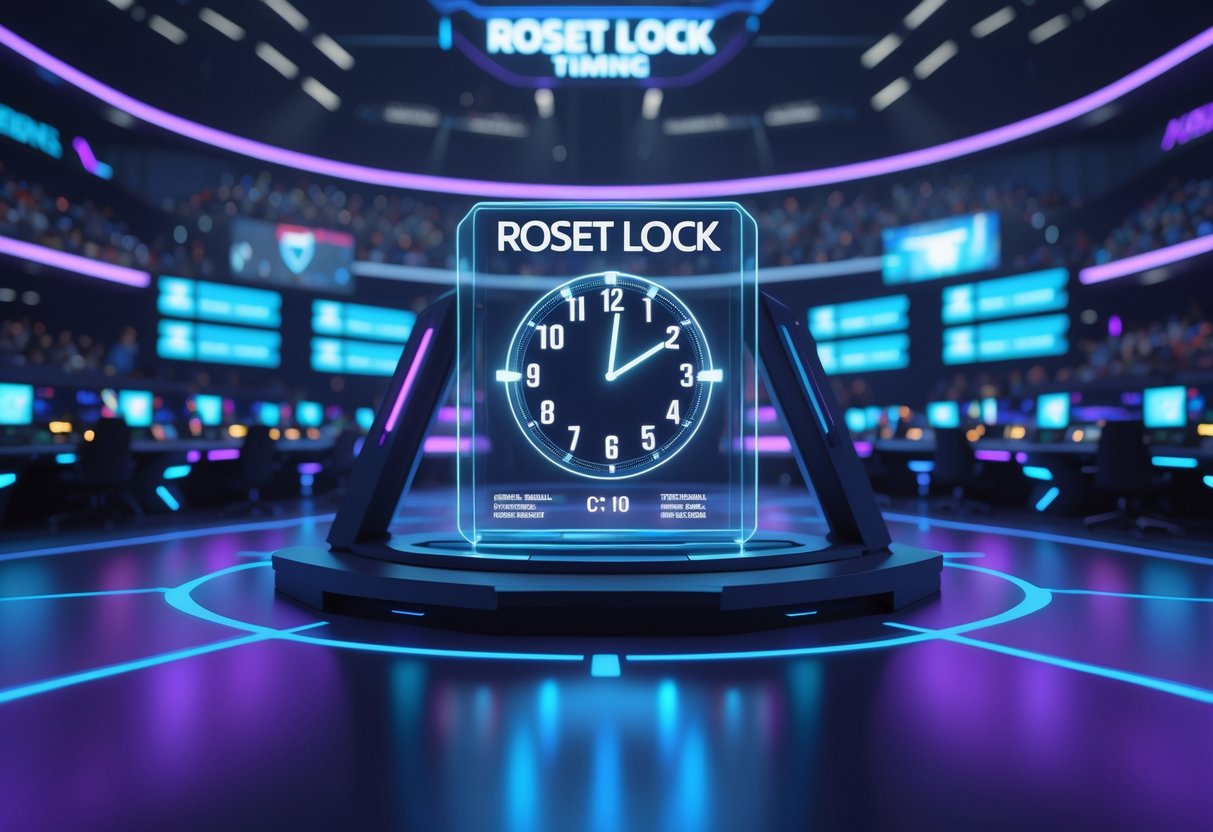Roster Lock Timing: Essential Guide for Fantasy and Esports
Updated On: October 26, 2025 by Aaron Connolly
Understanding Roster Lock Timing
Roster lock timing decides when teams can change their player lineups during competitions. This timing shifts between daily locks when each game starts, and weekly locks at the beginning of each matchup period.
Definition of Roster Lock
Roster lock marks the deadline when teams stop making changes to their active player lineups. This system keeps things fair and stops managers from swapping players after seeing match results or picking up an unfair edge.
Most fantasy leagues and esports competitions handle roster lock automatically. Once the lock hits, you can’t move players between active slots and bench positions until the next period.
There are two main types:
- Individual locks – Each player locks in when their specific match begins.
- Universal locks – Everyone locks in when the first match of the period kicks off.
The lock only affects lineup changes. Adding new players from free agency or making trades usually has separate, earlier deadlines.
Most platforms stick with individual locking as the default. This gives managers more freedom to tweak their lineups throughout the day or week.
Why Roster Lock Timing Matters
Roster lock timing can really shape your strategy and the fairness of competition. Early locks force you to commit to players before you know match conditions or any last-minute team changes.
Late individual locks let you react to news and injuries. You can swap players right up until their matches start. This makes things less about luck, but it does mean you have to manage your team more actively. Sometimes that’s a hassle, but some folks love the extra control.
Different timing setups lead to different experiences:
| Lock Type | Strategy Required | Time Commitment | Luck Factor |
|---|---|---|---|
| Weekly early lock | High planning | Low daily | Higher |
| Individual locks | Active monitoring | High daily | Lower |
Some competitions use roster locks to keep things fair and prevent managers from exploiting late info. If the timing isn’t right, someone could get an unfair jump by reacting to early match results.
The timing you pick changes the league dynamic. Casual players usually like weekly locks, but more competitive folks go for individual timing for deeper strategy.
Key Differences from Lineup Lock
Roster lock and lineup lock aren’t quite the same, even though people mix them up a lot. Roster lock just controls when you can change which players are active in your starting lineup.
Lineup lock usually covers bigger roster management stuff—like adding players from free agency, making trades, or activating players from injury lists.
Main differences:
- Roster lock: Moving players between active and bench slots.
- Lineup lock: All roster transactions, including adds and drops.
- Timing: Lineup locks usually happen before roster locks.
Platforms usually separate these. You might lose the chance to pick up new players at the first game of the day, but you can still move existing players around until their individual games start.
Knowing both types helps you plan your strategy. Quick tip: check your league settings before the season to see which lock system you’re dealing with.
How Roster Lock Works in Fantasy Sports

Roster locks stop you from changing your lineup once games begin. The timing can be daily or weekly, depending on your league. The system keeps things fair but still gives managers flexibility to adjust teams before matches start.
Weekly Versus Daily Locking Schedules
Weekly locks freeze your whole roster when the first game of the week starts. So, if Thursday night football kicks off, you’re stuck with your lineup until the next week.
Daily locks work differently. Players lock in individually when their games begin. If your quarterback plays on Sunday afternoon, you can still swap out bench players whose games haven’t started yet.
Weekly locking perks:
- Forces strategic planning
- Cuts down on luck from late injury news
- Easier to manage
Daily locking perks:
- More flexibility all week
- Lets you react to last-minute injury reports
- Helps you optimise your lineup
Most platforms lean toward daily individual locking. It’s just more flexible, especially for players who want to tinker with their teams.
Role of Commissioners in Lock Timing
League commissioners set the roster lock timing in private leagues. They can change these settings up to an hour before the draft. Public leagues just go with the platform defaults.
Commissioners pick from a few options:
- Lock individually at scheduled game time
- Lock all players at the first game of the day
- Lock weekly at first game
- Lock weekly with individual timing
The commissioner’s call shapes strategy for the whole season. Weekly locks reward planning. Daily locks reward quick moves and active management.
Honestly, it’s smart for commissioners to talk about lock timing with league members before the draft. Some experienced players want weekly locks to cut down on luck. Casual leagues often prefer daily individual locks for the freedom.
Impact on Player Lineup Decisions
Lock timing totally changes how you manage your roster. Weekly locks force you to set lineups by Thursday, even if your key players aren’t playing until Monday night.
With daily individual locks, you can hold off for injury reports and weather updates. That’s a lifesaver if your star player is questionable for Sunday.
Weekly lock strategies:
- Avoid players who might get hurt
- Don’t put Monday night guys in flex spots
- Set lineups early so you don’t forget
Daily lock strategies:
- Keep an eye on injury news all weekend
- Have flexible bench options ready
- Use late-game players as backup plans
The lock system also affects how you handle the waiver wire. Roster moves usually lock at the first game of each day, no matter what your lineup lock settings are.
Roster Lock Timing in Esports Tournaments

Roster lock deadlines set hard cutoffs for when teams must finalise their lineups for tournaments. These rules can vary a lot from game to game. Some tournaments let teams make changes up until the competition starts, while others lock things down months in advance.
Major Formats and Rules
Different esports titles use their own roster lock systems, depending on their competitive structures. For example, VALORANT Champions Tour makes teams register preliminary rosters months before events, then finalise them closer to tournament dates.
In the VCT 2024 season, teams had to submit rosters by May 27th for Champions, but the real lock didn’t happen until July 26th. That gave teams extra time for visas and last-minute tweaks.
Counter-Strike tournaments like BLAST lock rosters about a week before competition. This gives teams more flexibility, but also means quick decisions under pressure.
Apex Legends Global Series is stricter. Teams can’t change rosters after deadlines, and any changes mean losing your tournament invite. That’s a big deal—commitment over flexibility.
Dota 2 uses seasonal roster locks. Teams submit lineups for whole tournament circuits. Miss the deadline and you’re out of all Valve-sponsored events for that period.
Additions and Removals Deadlines
Player additions and removals have their own timing rules, depending on the tournament. Most leagues treat adding new players and replacing existing ones differently.
Adding substitute players usually has a more relaxed deadline. VALORANT lets teams carry 5-10 players, with sixth players as substitutes and no strict addition cutoff.
Removing players usually needs more notice. Teams often have to give 14 days’ notice, especially in franchised leagues where player contracts matter.
Some tournaments allow emergency replacements. If a player can’t play because of visa or health issues, organisers may grant deadline extensions.
Regional restrictions also play a part. Teams with international players need extra time for visas, which means earlier preliminary deadlines and later final locks.
Specifics for Competitors and Coaches
Coaches often have different roster lock rules than players. Lots of tournaments let teams swap coaches right up until the event starts, since coaches have less direct impact during matches.
Player eligibility means meeting certain criteria before the lock. Teams have to verify age, region, and contract paperwork.
Two-way contracts—like in VCT—let players compete for both main and academy teams. If they play in over half the matches at the top level, they face extra restrictions.
Loan arrangements need to fit specific timing windows. VCT teams can loan up to two players to lower-tier teams, but can’t receive loans themselves.
Transfer windows open up periods when teams can move players around. These close before actual roster locks, so there’s a gap between when you can sign someone and when you have to lock your lineup.
Draft Implications on Roster Lock

Draft events bring extra timing challenges that affect when rosters lock and how teams shuffle players. The link between draft schedules and roster lock rules changes a lot across different games and tournaments.
Timing of Roster Lock Relative to Draft
Most esports tournaments lock rosters before the draft phase begins. Teams have to submit final lineups 24-48 hours before draft day.
This stops last-minute swaps that could mess up the tournament schedule. League of Legends Championship Series locks rosters three days before each match week. Counter-Strike usually freezes lineups 48 hours before group stages.
If teams need emergency substitutions, they have to get special approval. Organisers want medical proof or visa documents before letting changes slide after the lock.
Some amateur tournaments are more chill and let teams swap players up to 30 minutes before the draft. That’s helpful for smaller orgs dealing with player no-shows.
Post-Draft Roster Adjustments
After drafts wrap up, most tournaments ban roster changes. The draft is your commitment to that lineup.
Substitute players only get to play if they were registered before the original lock. Teams usually register 6-7 players but only 5 actually play in matches.
Fantasy esports platforms do things differently. Many let you change your lineup between draft and match start. You can swap players based on draft results or map picks.
Mid-tournament emergencies sometimes make organisers bend the rules for medical issues, but teams might get hit with penalties like map bans or starting at an economic disadvantage.
Pre-Draft Versus Post-Draft Rules
Before the draft, teams have the most flexibility. They can negotiate transfers, sign free agents, and finalise contracts.
Registration deadlines usually fall 1-2 weeks before tournaments. Teams must submit full rosters—including subs and coaches—during this window.
After the draft, rules get much tighter. Most tournaments treat the draft as a binding deal between the team and their players.
Penalties depend on the level:
- Pro leagues: Forfeit if you make unauthorised changes
- Semi-pro: Map or economic penalties
- Amateur: Warnings or docked points
Some tournaments allow roster lock exemptions for technical issues. If servers crash during the draft, teams might get more time to finalise lineups without penalty.
Popular Platforms and Their Roster Lock Policies

Different fantasy platforms each have their own approach to roster lock timing. ESPN offers the most flexibility with four lock settings, while Yahoo Fantasy keeps things simple with two main options.
ESPN
ESPN gives league managers four different roster lock options. By default, it locks players individually when their games start. So, you can still shuffle your lineup as long as each player’s game hasn’t kicked off yet.
The “Daily – Lock at First Game of Day” option freezes your entire roster once the first match begins. If Thursday Night Football starts at 8:20 PM, your whole lineup locks right then.
ESPN’s Four Lock Options:
- Individual game time locks (default)
- Daily lock at first game
- Weekly individual locks
- Weekly lock at first game
For weekly formats, ESPN lets you lock either individual players when their games start or the whole roster at the week’s first match. League managers can tweak these settings up to one hour before the draft.
Roster vs Lineup Locks
ESPN separates roster moves from lineup changes. You can add or drop players until the first scheduled game of the day. Moving players between your starters and bench depends on your chosen lock setting.
Yahoo Fantasy
Yahoo Fantasy keeps things simpler with two main roster lock options. Most leagues stick with the individual lock system, so players freeze when their specific games begin.
The “All at first game start” setting locks every player once the week’s opening match starts. No more lineup tinkering for the rest of the scoring period.
Yahoo’s Lock Times:
- Individual at game start (most common)
- All players at first game start
Yahoo’s individual system lets you stay flexible throughout the week. If Sunday’s 1 PM games have started but Monday Night Football hasn’t, you can still adjust players in that late matchup.
Yahoo doesn’t separate roster and lineup locks like ESPN does. All player moves follow the same timing rules your league sets up.
Other Major Fantasy Platforms
Most other fantasy platforms stick to patterns similar to ESPN and Yahoo. Individual player locks are still the most popular option across the board.
Sleeper uses individual game locks as its default. Players freeze when their specific matches start, which gives you a lot of wiggle room for late swaps.
NFL.com gives you both individual and “all at first game” options. This setup mirrors Yahoo’s main choices.
CBS Sports also defaults to individual locks. If commissioners want a stricter setup, they can switch to full roster locks.
Smaller platforms usually offer at least individual locking. The “lock at first game” option has become standard pretty much everywhere, thanks to league managers asking for it.
Lineup Versus Roster Lock: Key Distinctions

Fantasy sports platforms actually run two different lock systems that control different parts of team management. Knowing when you can move players versus when you can add or drop them is the difference between a win and a loss.
Player Movement Restrictions
Lineup locks just affect moving players between your starters and bench. You can swap a benched player into your lineup right up until their lock time.
This kind of lock doesn’t stop you from adding new players from free agency. You can still drop players and pick up free agents during lineup lock periods.
Roster locks are stricter. When roster lock hits, you can’t add, drop, or trade any players until the next scoring period starts.
Here’s the main difference: lineup lock means no position swaps, roster lock means no transactions at all. Most leagues run both systems at once.
If your league locks lineups individually, you can still move around any players whose games haven’t started. Only players in games that have kicked off become frozen.
Transaction Deadlines
Roster transactions have tighter deadlines than lineup changes. Adding players from waivers or free agency usually locks at the first scheduled game of the day.
Draft day sets the first roster lock. After your draft wraps up, regular season lock rules kick in right away.
Trading deadlines often match up with roster locks. Once the first game starts, no more trades go through until the next matchup period.
Some platforms lock all transactions at Thursday’s first game, even if it’s just one early matchup. Others wait until Sunday’s main slate.
Waiver claims typically process overnight, before games start. So your roster changes usually happen before either lock type kicks in.
Quick win: Check your league’s transaction log to see exactly when moves stop each week.
Weekly Versus Individual Game Locks
Individual game locking lets you manage players whose games haven’t started yet. Your Thursday night players lock early, but Sunday afternoon guys stay moveable.
This setup rewards managers who stay on top of news. You can adjust for late injuries or weather delays that pop up right before games.
Weekly locks freeze everything at once. When Thursday’s game kicks off, your whole roster is stuck until the next week.
| Lock Type | Flexibility | Strategy Impact |
|---|---|---|
| Individual | High | Rewards research |
| Weekly | None | Reduces time commitment |
Most experienced fantasy players go for individual locks. It opens up more strategic choices and helps you react to unexpected news.
Heads up: Some leagues lock lineups individually but use weekly roster locks for transactions. Double-check both before your draft.
Weekly locks work better for casual players who can’t keep up with injury reports all weekend. Individual locks are for managers who want full control.
Consequences of Roster Lock Timing

Roster lock timing sets hard deadlines that force you to make quick decisions about player moves and team composition. These rules change how teams approach trades and shape your strategy for the whole season.
Effect on Trades and Transfers
Roster lock timing decides exactly when player transactions shut down. Once the lock hits, you can’t add new players or trade until the next unlock period.
Each platform sets its own timing. Some lock rosters when the first match begins each day. Others freeze lineups at the start of each individual player’s game.
Miss a roster lock and you’re stuck with your current squad, even if someone gets hurt or underperforms.
Daily roster locks give you more chances to make moves. You can adjust between matches or add players whose games haven’t started. Weekly locks offer fewer chances but let you overhaul your roster all at once.
Trade talks have to factor in these deadlines. Deals you discuss all week fall apart if you don’t finish before lock. It’s honestly pretty common to lose out on trades just because the clock ran out.
When emergencies hit—like a player getting injured after lock—you’re out of luck. No quick fixes until the next unlock.
Roster Freeze Impact on Strategy
Teams have to plan everything around roster lock schedules. You need to think ahead about player availability, injuries, and performance trends before the deadline.
Under weekly lock systems, early-week prep matters more. Teams do their research and set lineups in advance so they’re not scrambling at the last minute.
Long-term roster building shifts with different lock timings. Weekly locks make deep benches more valuable since you can’t swap mid-period. Daily locks let you get by with fewer backups.
Roster locks force you to choose between sticking with your lineup or chasing short-term upside by making more moves.
Match scheduling adds another layer of strategy. Thursday games in weekly formats can lock your roster before you’re ready. That’s three fewer days to make moves or gather info.
The pressure ramps up as lock time approaches. Sometimes, last-minute decisions backfire compared to moves you planned out earlier in the week.
Adjusting and Editing Roster Lock Settings

Commissioners control roster lock timing through league settings. Most changes can happen during the season, but some need to happen before your draft starts.
Commissioner Tools and Options
We can update roster lock settings in the league management dashboard. The main choices are individual player locks or full roster locks at the first game.
Individual Player Locks are the default. Each player locks when their game starts. This gives managers the most flexibility.
Full Roster Lock freezes everyone when the first scheduled game starts. It’s a more strategic environment but limits your options for late lineup changes.
You have to set the roster lock type before your draft. Once the season starts, that core timing can’t be changed.
Most platforms also offer:
- Emergency roster adjustments for commissioners only
- Temporary lock overrides for special cases
- Custom lock times for specific weeks
Changing Lock Times Mid-Season
You can’t swap the main roster lock type during an active season. Your choice—individual or full roster lock—sticks after the draft.
Some roster-related settings can be tweaked mid-season. Positional limits can go up or down at any time. Bench slots can be added, but not taken away.
Waiver periods and trade deadlines change independently of roster locks. These updates take effect for future transactions.
Heads up: Any scoring changes hit the entire season retroactively. Always tell your league about big changes before flipping any switches.
If there’s an emergency, commissioners can step in and make manual roster moves. Most platforms allow this for technical issues or honest mistakes.
Special Events and Roster Lock Dates

Major tournaments and holiday periods bring their own roster lock challenges. These special times usually come with earlier deadlines and stricter rules to fit broadcast schedules and travel logistics.
Playoffs and Championship Locks
Championship events always use stricter roster locks than regular games. Teams have to submit their lineups weeks or even months ahead.
Big tournaments usually set two main deadlines:
- Initial roster submission: 2-3 months before the event
- Final roster lock: 2-4 weeks before competition starts
The Shanghai Major followed this pattern. Teams hit their first roster lock on 7 September, almost three months before the tournament. That deadline locked in five starting players.
A second lock came on 22 September, covering subs and last-minute changes.
Why do championships need early locks?
- Venues need exact player numbers for planning
- Visa processing for international players takes weeks
- Broadcast graphics and promos need finalized rosters
- Travel plans have to be set up well in advance
Missing a roster lock can mean automatic disqualification. It’s harsh, but organizers stick to those rules.
Holiday or Split Event Policies
Holidays and split tournaments create scheduling headaches that mess with roster lock timing. Game publishers tweak their policies to deal with smaller staff and weird schedules.
Usual holiday adjustments:
- Longer lock periods: Roster changes freeze for whole holiday weeks
- Earlier deadlines: Teams must confirm lineups before staff breaks
- Limited support: Tech issues might take longer to fix
Split events are tricky. Tournaments can last weeks or months, with qualifiers in one lock period and finals in another.
Organizers usually handle splits by:
- Setting separate locks for each phase
- Allowing limited changes between qualifiers and finals
- Tightening rules as the event gets bigger
Timing gets even tougher when holidays overlap with big events. Christmas and New Year often mean extended roster locks to cover for limited admin support.
Teams that plan ahead do better. The best organizations mark special event deadlines months out and leave buffer time for roster decisions.
Best Practices for Managing Roster Locks
Managing roster locks well really comes down to planning ahead and dodging common pitfalls that can cost you wins. You need to know your league’s timing rules and develop good habits for deadline management.
Planning Ahead for Deadlines
Check your roster at least twice a week so you don’t get caught scrambling at the last minute. Set reminders on your phone—maybe Wednesday evenings and again an hour before your earliest player’s match.
Try building a weekly routine that fits your life. Some fantasy managers peek at lineups during lunch or even while they’re on the train. That kind of habit can really save you from deadline disasters.
When your league uses individual kickoff locks, keep an eye on when your starters play. Thursday night games sneak up on people—they start earlier than most weekend fixtures.
Keep a simple checklist:
- Check injury reports by Wednesday
- Glance at weather forecasts for outdoor matches
- Set your phone to alert you 2 hours before the earliest kickoff
- Make sure you’ve got backup options on your bench
Traveling messes with time zones, so always convert lock times to wherever you are. Double up on reminders if you’re not home.
Common Mistakes to Avoid
Many people assume every league uses the same lock system, but that’s just not true. Check your league’s rules in the first week, or you might get burned.
Don’t save lineup changes for Sunday morning in weekly lock leagues. Thursday night games will freeze your whole roster, and you could end up stuck with injured players.
Watch out for these:
- Missing early Thursday kickoffs
- Forgetting to turn on mobile app notifications
- Leaving injured players in your flex spots too long
- Making last-second panic moves
Roster locks stop all transactions, not just lineup swaps. Once locks hit, you can’t drop, trade, or claim free agents.
Heads up: Some platforms have different lock times for trades and lineup changes. Check both deadlines so you don’t get caught off guard.
Regional and Game-Specific Roster Policies

Fantasy sports platforms all handle roster locks a bit differently, depending on the sport and league. Every game has its own timing rules, and new players often get tripped up by them.
Differences Among League Types
NFL fantasy leagues usually use individual player locks. Each player locks when their game starts—Sunday, Monday, or Thursday.
Most ESPN leagues default to this. You can swap players right up until kickoff.
MLB fantasy works differently since games happen almost every day. Roster moves lock at the first game of the day, usually around 1:00 PM ET.
After any MLB game starts that day, you can’t add or drop players. But you can still move players between your active roster and bench if their specific games haven’t started.
Basketball and hockey leagues follow similar daily lock patterns. The main difference? These sports play several times a week, not just once.
Here’s a quick comparison:
| Sport | Lock Timing | Frequency |
|---|---|---|
| NFL | Individual kickoffs | Weekly |
| MLB | First daily game | Daily |
| NBA/NHL | Individual tip-offs | 3-4 times weekly |
Unique Situations in Various Regions
Premier League fantasy uses a weekly lock with its own quirks. All transfers must be done before the first match of each gameweek.
This changes your strategy compared to American leagues. Once the gameweek starts, you can’t react to early injury news.
European competitions like Champions League fantasy make things stricter. Squads lock 24-48 hours before the first match of each round.
Australian Fantasy Football (AFL) uses a hybrid system. Player prices change all week, but lineups lock individually at bounce time.
Some platforms let you use a “rolling lockout” where only matches already played lock. That means you can still make changes for unplayed games.
Quick tip: Always check your league’s lock settings in the rules. League managers can usually tweak these right up until an hour before your draft.
Frequently Asked Questions

Teams and players run into the same questions about deadlines, emergency replacements, and appeals. These are the most common concerns people ask about.
When is the deadline for submitting team line-ups for the upcoming competition?
Most esports tournaments want roster submissions 48-72 hours before things kick off. Big tournaments like CS2 majors usually lock rosters a week ahead.
League-based competitions mix it up. Weekly leagues often lock rosters 24 hours before the first match. Monthly tournaments ask for submissions 3-5 days in advance.
Organizers usually send you a reminder email about a week before the deadline. Submit your roster early if you can—you don’t want to deal with technical issues at the last minute.
Could you explain the rules around changing players after the team list has been finalised?
Once rosters lock, most tournaments don’t allow any substitutions. That means you can’t swap out inactive players or change roles.
Some competitions allow emergency substitutions only if you show written proof—like illness, injury, or a family emergency. Officials need to approve these changes within a couple hours.
Regional qualifiers usually get stricter than online tournaments. LAN events almost always block all changes after lock to keep competitive integrity intact.
Are there any exceptions that allow for roster alterations after the established cut-off point?
Tournament organizers usually only accept medical emergencies as exceptions. Players must turn in a doctor’s note or hospital papers within 24 hours.
Family emergencies—like deaths or serious illness—sometimes count too. Directors review each case and want official documentation.
Technical issues almost never qualify. Problems like internet outages or hardware failures don’t let you change your roster after the deadline.
How does the transfer window affect the timings for roster locks?
Transfer windows only matter in pro leagues with signed contracts. Most amateur and semi-pro tournaments skip transfer restrictions.
Professional leagues like the League of Legends Championship Series have set transfer periods between seasons. Teams can only make changes during those windows.
Tournament roster locks work separately from transfer windows. Even if transfers are open, you still have to meet each competition’s deadline.
What happens if a player needs to be replaced due to an emergency following the roster lock?
Teams need to contact tournament officials right away—usually by email or Discord. Most organizers want to hear from you within 2-6 hours of the emergency.
You’ll have to provide documentation for emergency subs. That means medical notes, police reports, or even a death certificate.
Substitute players must already be registered in the tournament system. Last-minute additions almost never get approved, so always register backup players when you first submit your roster.
Can you outline the process for appealing a roster lock decision?
You’ve got to send in your appeal in writing within 24 hours of the decision. Most tournaments give you a specific email or a form to fill out for this.
If you want a real shot at winning the appeal, you’ll need some solid evidence. Screenshots, medical notes, or even statements from witnesses can really help your case.
Usually, someone on the tournament side will get back to you in 12 to 48 hours, although bigger events might take a bit longer. Some major competitions even have a whole committee just for appeals, so they’ll dig into your case more carefully.
A lot of tournaments charge an appeal fee—anywhere from £10 to £50. They do this to cut down on appeals that aren’t serious. If you actually win your appeal, they’ll refund your fee.

